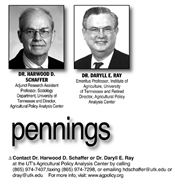Land Security, Displacement, And Internationally Coordinated Agricultural Policy

Traditionally, agricultural policy has been designed country by country with most, if not all, countries trying to provide a degree of protection for their farmers while at the same time maximizing their competitiveness in the global trade of agricultural products. From our perspective, policies with the goal of maximizing competitiveness have taken precedence over those that would provide protection for agricultural producers.
In last week’s column, we proposed the development of a coordinated international set of supply management policies that in addition to providing farmers with a degree of price protection would also build a dispersed set of national and international reserve stocks to protect the world’s population from disruptions in the supply of essential storable grains and oilseeds.
The second element in our suite of agricultural policies designed to address the 4 crises we examined in recent columns (endemic hunger, food availability, food affordability, and farm profitability) is the need to provide all producers of agricultural products with land security.
Most of the beneficiaries of supply management policies for storable agricultural commodities are involved in extensive production and manage larger landholdings than the majority of the world’s agricultural producers who work relatively small parcels of ground.
These larger producers also generally have secure title to the land that they work.
This is not true for many small holders around the world who engage in crop and animal agriculture as a means of feeding their family and sell any surplus they produce within a small geographical area. They may have traditional rights to work the land, but they often lack the kind of land titles that protect farmers in more developed regions of the world.
Before we talk about land use rights or security in land use for many smallholders around the world, let’s look at a challenge that many farmers face. In a word it is called displacement. Farmers can be displaced by both urban sprawl and industrial development. This is particularly critical for farming areas adjacent to urban areas.
Yes, farmers with clear titles can sell their land for a pretty penny and retire or purchase land elsewhere. But compensation for farmers may not be the critical issue. It may be more important to ask whether we want to pave over some of the most fertile, productive land in the world to provide space for homes, roads, shopping areas, warehouses, and industrial tracts? As two who enjoy their suburban lifestyle, we still have to ask whether or not it makes more sense to expand our cities vertically instead of horizontally.
Protection from this type of displacement must involve significant discussions, both nationally and internationally, at the intersection of agricultural policy and urban/industrial policy.
The second displacement threat comes from global warming. We see at least two distinct threats from global warming: rising sea levels, and massive fires of a size we have not previously seen in our lifetimes.
In the case of climate change, farmers and urban residents in both developed and less developed countries are literally in the same boat.
We will all have to pay a significant price if we do not address climate policy – the sooner the better.
In the developing and least developed areas of the world we need to address the need to protect the use of communal resources like forests and savannas. Farmers and pastoralists in many areas of the world need policies that ensure their continued use of these traditional resources.
In addition, we need to protect the rights of pastoralists who move their animals from seasonal pasture to seasonal pasture during the year. Traditionally this seasonal movement has been called transhumance as pastoralists move their animals from the lower altitude pastures that they use in the winter to higher altitude pastures that provide abundant grazing areas in the late spring and summer. But temperature is not the only factor that causes pastoralists to move their animals. Rainfall patterns may give pastoralists reason the move their animals hundreds of miles back and forth between grazing areas that are dependent on seasonal rainfall patterns.
In a modern milieu where things that once were given little thought now require documentation, it is time to protect the movement and access rights of pastoralists.
Compared to the land security challenges we have raised in this column; commodity policy suddenly seems like a walk in the park. ∆
DR. HARWOOD D. SCHAFFER: Adjunct Research Assistant Professor, Sociology Department, University of Tennessee and Director, Agricultural Policy Analysis Center
DR. DARYLL E. RAY: Emeritus Professor, Institute of Agriculture, University of Tennessee and Retired Director, Agricultural Policy Analysis Center